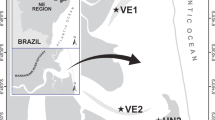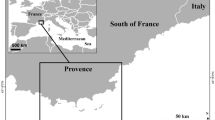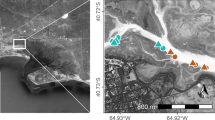Abstract
Three common vegetation types were studied to assess habitat partitioning in juvenile fishes in select warm temperate estuaries of South Africa. Vegetated habitat types are known as productive and important areas for predator avoidance and feeding and are often preferred by juvenile fishes. Habitat partitioning is not well understood, with previous studies mostly focusing on seagrass (Zostera capensis). This study aimed to assess three common vegetated fish nursery areas in estuaries to aid conservation planning. Fishes were collected by means of double-winged, six-hooped fyke nets, 1 mm mesh size secured in placed on the nocturnal flood tide at each inundated vegetation type (Phragmites australis, Zostera capensis, Spartina maritima) and at an adjacent unvegetated site for three consecutive months in 2014 and 2015 during the summer recruitment period for juvenile fishes. Higher catches were frequently recorded in vegetated areas for solely estuarine and marine estuarine dependent species. In general, the previously unstudied reed, P. australis showed the highest species richness and abundance of juvenile fishes overall, followed by, Z. capensis and the intertidal salt marsh species, S. maritima. Results from this study supports international trends on the value of vegetated areas as refugia for young fishes in estuaries.



Similar content being viewed by others
References
Able KW (2005) A re-examination of fish estuarine dependence: evidence for connectivity between estuarine and ocean habitats. Estuar Coast Shelf Sci 64:5–17
Able KW, Hagan SM (2000) Effects of common reed (Phragmites australis) invasion on marsh surface macrofauna: response of fishes and decapod crustaceans. Estuaries 23:633–648
Adams JB (2016) Distribution and status of Zostera capensis in south African estuaries - a review. S Afr J Bot 107:63–73
Adams JB, Bate GC, O’Callaghan M (1999) Estuarine primary producers. In: Allanson BR, Baird D (eds) Estuaries of South Africa. Cambridge University Press, Cambridge, pp 91–118
Blaber SJ (1973) The ecology of juvenile Rhabdosargus holubi (Steinachner) (Teleostei: Sparidae). PhD thesis. Rhodes University, South Africa, p 123
Beck MW, Heck KL, Able KW, Childers DL, Eggleston DB, Gillanders BM, Halpern B, Hays CG, Hosino K, Minello TJ, Orth RJ, Sheridan PF, Weinstein MP (2001) The identification, conservation, and management of estuarine and marine nurseries for fish and invertebrates. Biosci 51:633–641
Beckley LE (1983) The ichthyofauna associated with Zostera capensis Setchell in the Swartkops estuary, South Africa. S Afr J Zool 18:15–24
Beckley LE (1984) Fish community structure in Zostera and non-Zostera regions of the Kromme estuary, St Francis bay. S Afr J Zool 19:296–301
Boehlert GW, Mundy BC (1984) Roles of behavioural and physical factors in larval and juvenile fish recruitment to estuarine nursery areas. Am Fish Soc Symp 3:51–67
Booth TL (2007) The ichthyofauna associated with Taylor’s salt marsh, Kariega estuary (eastern cape). Rhodes University (MSc Thesis), South Africa, p 106
Branch GM, Grindley JR (1979) Ecology of southern African estuaries part XI. Mngazana: a mangrove estuary in the Transkei. S Afr J Zool 14:149–170
Bruno DO, Barbini SA, de Astarloa JMD, Martos P (2013) Fish abundance and distribution patterns related to environmental factors in a chocked temperate lagoon (Argentina). Braz J Oceanogr 61:43–53
Carassou L, Whitfield AK, Bergamino L, Moyo S, Richoux NB (2016) Trophic dynamics of the cape Stumpnose (Rhabdosargus holubi, Sparidae) across three adjacent aquatic habitats. Estuar Coasts 39:1221–1233
Connolly RM (1994) A comparison of fish assemblages from seagrass and unvegetated areas of a southern Australian estuary. Aust J Mar Freshw Res 45:1033–1044
Clark KL, Ruiz GM, Hines AH (2003) Diel variation in predator abundance, predation risk and prey distribution in shallow-water estuarine habitats. J Exp Mar Biol Ecol 287:37–55
Dance MA, Rooker JR (2015) Habitat- and bay-scale connectivity of sympatric fishes in an estuarine nursery. Estuar Coast Shelf Sci 167:447–457
De Wet PS, Marais JFK (1990) Stomach content analysis of juvenile cape stumpnose Rhabdosargus holubi in the Swartkops estuary, South Africa. S Afr J Mar Sci 9:127–133
Edworthy C, Strydom NA (2016) Habitat partitioning by juvenile fishes in a temperate estuarine nursery, South Africa. Sci Mar 80:151–161
Ferrell DJ, Bell JD (1991) Differences among assemblages of fish associated with Zostera capricorni and bare sand over a large spatial scale. Mar Ecol Prog Ser 72:15–24
França S, Vasconcelos RP, Tanner S, Máguas C, Costa MJ, Cabral HN (2011) Assessing food web dynamics and relative importance of organic matter sources for fish species in two Portuguese estuaries: a stable isotope approach. Mar Environ Res 7:204–215
Franco A, Franzoi P, Malavasi S, Riccato F, Torricelli P (2006) Fish assemblages in different shallow water habitats of the Venice lagoon. Hydrobiologia 555:159–174
Gannon R, Payne NL, Suthers IM, Gray CA, Van der Meulen DA, Taylor MD (2015) Fine-scale movements, site fidelity and habitat use of an estuarine dependent sparid. Environ Biol Fish 98:1599–1608
Gratwicke B, Speight MR (2005) The relationship between fish species richness, abundance and habitat complexity in a range of shallow tropical marine habitats. J Fish Biol 66:650–667
Guidetti P (2000) Differences among fish assemblages associated with nearshore Posidonia oceanica seagrass beds, rocky–algal reefs and unvegetated sand habitats in the Adriatic Sea. Estuar Coast Shelf Sci 50:515–529
Hanekom N, Baird D (1984) Fish community structures in Zostera and non-Zostera regions of the Kromme estuary, St Francis bay. S Afr J Zool 19:295–301
Hanekom N, Baird D (1988) Distribution and variations in seasonal biomass of eelgrass Zostera capensis in the Kromme estuary, St Francis bay, South Africa. S Afr J Zool 7:51–59
Harrison TD, Whitfield AK (2006) Estuarine typology and the structuring of fish communities in South Africa. Environ Biol Fish 75:269–293
Heck KL, Thoman TA (1984) The nursery role of seagrass meadows in the upper and lower reaches of the Chesapeake Bay. Estuaries 7:70–92
Henninger TO, Froneman PW, Richoux NB, Hodgson AN (2009) The role of macrophytes as a refuge and food source for the estuarine isopod Exosphaeroma hylocoetes (Barnard, 1940). Estuar Coast Shelf Sci 82:285–293
Herzka SZ (2005) Assessing connectivity of estuarine fishes based on stable isotope ratio analysis. Estuar Coast Shelf Sci 64:58–69
Hosack GR, Dumbauld BR, Ruesink JL, Armstrong DA (2006) Habitat associations of estuarine species: comparisons of intertidal mudflat, seagrass (Zostera marina), and oyster (Crassostrea gigas) habitats. Estuar Coasts 29:1150–1160
Hudges JE, Deegan LA, Wyda JC, Weaver MJ, Wright A (2002) The effects of eelgrass habitat loss on estuarine fish communities of southern New England. Estuaries 25:235–249
Humphries P, Potter IC, Loneragan NR (1992) The fish community in the shallows of a temperate Australian estuary: relationships with the aquatic macrophyte Ruppia megacarpa and environmental variables. Estuar Coast Shelf Sci 34:325–346
Hunter-Thomson K, Hughes J, Williams B (2002) Estuarine–open-water comparison of fish community structure in eelgrass (Zostera marina L.): habitats of cape cod. Biol Bull 203:247–248
Islam MS, Hibino M, Tanaka M (2007) Tidal and diurnal variations in larval fish abundance in an estuarine inlet in Ariake Bay, Japan: implication for selective tidal stream transport. Ecol Res 22:165–171
Jenkins GP, Wheatley M (1998) The influence of habitat structure on nearshore fish assemblages in a southern Australian embayment: comparison of shallow seagrass, reef-algal and unvegetated sand habitats, with emphasis on their importance to recruitment. J Exp Mar Biol Ecol 221:147–172
Jenkins GP, May HMA, Wheatley MJ, Holloway MG (1997) Comparison of fish assemblages associated with seagrass and adjacent unvegetated habitats of port Phillip Bay and corner inlet, Victoria, Australia, with emphasis on commercial species. Estuar Coast Shelf Sci 44:569–588
Jones KMM, Able KW (2015) Abundance and diet of predatory fishes in Phragmites, treated Phragmites, and natural Spartina marshes in Delaware Bay. Estuar Coasts 38:1350–1364
Jones KMM, McGrath PE, Able KW (2014) White perch Morone americana (Gmelin, 1789) habitat choice and movements: comparisons between Phragmites-invaded and Spartina reference marsh creeks based on acoustic telemetry. J Exp Mar Biol Ecol 455:14–21
Jordan F, Coyne S, Trexler JC (1997) Sampling fishes in vegetated habitats: effects of habitat structure on sampling characteristics of the 1-m2 throw trap. Trans Am Fish Soc 126:1012–1020
Joseph V, Schmidt AL, Gregory RS (2013) Use of eelgrass habitats by fish in eastern Canada. DFO Canadian Science Advisory Secretariat Research Document. 2012/138
Kisten Y, Pattrick P, Strydom NA, Perissinotto R (2015) Dynamics of recruitment of larval and juvenile cape stumpnose Rhabdosargus holubi (Teleostei: Sparidae) into the Swartkops and Sundays estuaries, South Africa. S Afr J Mar Sci 37:1–10
Lee C, Huang Y, Chung C, Lin H (2014) Tidal variation in fish assemblages and trophic structures in tropical indo-Pacific seagrass beds. Zool Stud 53:56
Lemley DA, Adams JB, Strydom NA (2017) Testing the efficacy of an estuarine eutrophic condition index: does it account for shifts in flow conditions? Ecol Indic 74:357–370
Levin P, Petrik R, Malone J (1997) Interactive effects of habitat selection, food supply and predation on recruitment of an estuarine fish. Oecologia 112:55–63
Lubbers L, Boynton WR, Kemp WM (1990) Variations in structure of estuarine fish communities in relation to abundance of submersed vascular plants. Mar Ecol Prog Ser 65:1–14
Marais JFK (1988) Some factors that influence fish abundance in south African estuaries. S Afr J Mar Sci 6:67–77
Moncreiff CA, Sullivan MJ (2001) Trophic importance of epiphytic algae in subtropical seagrass beds: evidence from multiple stable isotope analyses. Mar Ecol Prog Ser 215:93–106
Nel L, Strydom NA, Perissinotto R, Adams JB, Lemley DA (2017) Feeding ecology of Rhabdosargus holubi (family Sparidae) in multiple vegetated refugia of selected warm temperate estuaries in South Africa. Estuar Coast Shelf Sci 197:194–204
Nanjo K, Nakamuru Y, Horinouchi M, Kohno H, Sano M (2011) Predation risks for juvenile fishes in a mangrove estuary: a comparison of vegetated and unvegetated microhabitats by tethering experiments. J Exp Mar Biol Ecol 405:53–58
Paterson AW (1998) Aspects of the ecology of fishes associated with salt marshes and adjacent habitats in a temperate south African estuary. PhD thesis. Rhodes University, Grahamstown, p 200
Paterson AW, Whitfield AK (2003) The fishes associated with three intertidal salt marsh creeks in a temperate southern African estuary. Wetl Ecol Manag 11:305–315
Pasquaud S, Vasconcelos RP, França S, Henriques S, Costa MJ, Cabral H (2015) Worldwide patterns of fish biodiversity in estuaries: effect of global vs. local factors. Estuar Coast Shelf Sci 154:122–128
Pattrick P, Strydom NA (2014) Recruitment of fish larvae and juveniles into two estuarine nursery areas with evidence of ebb tide use. Estuar Coast Shelf Sci 149:120–132
Potter IC, Claridge PN, Hyndes GA, Clarke KR (1997) Seasonal, annual and regional variations in ichthyofaunal composition in the inner Severn estuary and inner Bristol channel. J Mar Biol Assoc UK 77:507–525
Potter IC, Tweedley JR, Elliot M, Whitfield AK (2015) The ways in which fish use estuaries: a refinement and expansion of the guild approach. Fish Fish 16:230–239
Richardson N, Whitfield AK, Paterson AW (2006) The influence of selected environmental parameters on the distribution of the dominant demersal fishes in the Kariega estuary channel, South Africa. Afr Zool 41:89–102
Rotherham D, West RJ (2002) Do different seagrass species support distinct fish communities in South-Eastern Australia? Fish Manag Ecol 9:235–248
Rozas LP, Odum WE (1988) Occupation of submerged aquatic vegetation by fishes: testing the roles of food and refuge. Oecologia 77:101–106
Schaffler JJ, Van Montfrans J, Jones JM, Orth RJ (2013) Fish species distribution in seagrass habitats of Chesapeake Bay are structured by abiotic and biotic factors. Mar Coast Fish 5:114–124
Schein A, Courtenay SC, Crane CS, Teather KL, Van der Heuvel MR (2012) The role of submerged aquatic vegetation in structuring the nearshore fish community within an estuary of the southern gulf of St. Lawrence. Estuar Coasts 35:799–810
Sheppard JN (2010) Structure and functioning of fish assemblages in two South African estuaries, with emphasis on the presence and absence of submerged macrophyte beds. Rhodes University (MSc Thesis), 155 p
Sheppard JN, Whitfield AK, Cowley PD, Hill JM (2012) Effects of altered estuarine submerged macrophyte bed cover on the omnivorous cape stumpnose Rhabdosargus holubi. J Fish Biol 80:705–712
Smith MM, Heemstra PC (1995) Smith’s Sea Fishes. Southern Book Publishers, Johannesburg, pp 1047
Smith TM, Jenkins GP, Hutchinson N (2012) Seagrass edge effects on fish assemblages in deep and shallow habitats. Estuar Coast Shelf Sci 115:291–299
Strydom NA (2015) Patterns in larval fish diversity, abundance, and distribution in temperate South African estuaries. Estuar Coasts 38:268–284
Ter Morshuizen LD, Whitfield AK (1994) The distribution of littoral fish associated with eelgrass Zostera capensis beds in the Kariega estuary, a southern African system with a reversed salinity gradient. S Afr J Mar Sci 14:95–105
Thomas BE, Connolly RM (2001) Fish use of subtropical salt marshes in Queensland, Australia: relationships with vegetation, water depth and distance onto the marsh. Mar Ecol Prog Ser 209:275–288
Underwood GJC, Kromkamp J (1999) Primary production by phytoplankton and microphytobenthos in estuaries. Adv Ecol Res 29:93–153
Van Niekerk L, Turpie JK (2012) South African National Biodiversity Assessment 2011: technical report. Volume 3: Estuary component. CSIR report number CSIR/NRE/ECOS/ER/2011/0045/B. Council for Scientific and Industrial Research, Stellenbosch
Valiñas MS, Molina LM, Addino M, Montemayor DI, Acha EM, Iribarne OO (2011) Biotic and environmental factors affect Southwest Atlantic salt marsh use by juvenile fishes. J Sea Res 68:49–56
Vasconcelos RP, Reis-Santos P, Costa MJ, Cabral HN (2011) Connectivity between estuaries and marine environment: integrating metrics to assess estuarine nursery function. Ecol Indic 11:1123–1133
Vasconcelos RP, Henriques S, França S, Pasquaud S, Cardoso I, Laborde M, Cabral HN (2015) Global patterns and predictors of fish species richness in estuaries. J Anim Ecol 84:1331–1341
Vorwerk PD, Whitfield AK, Cowley PD, Paterson AW (2003) The influence of selected environmental variables on fish assemblage structure in a range of southeast African estuaries. Environ Biol Fish 66:237–247
Weis JS, Weis P (2003) Is the invasion of the common reed, Phragmites australis, into tidal marshes of the eastern US an ecological disaster? Mar Pollut Bull 46:816–820
Whitfield AK (1994) Abundance of larval and 0+ juvenile marine fishes in the lower reaches of three southern African estuaries with differing freshwater inputs. Mar Ecol Prog Ser 105:257–267
Whitfield AK (1998) Biology and ecology of fishes in southern African estuaries. Ichthyological Monographs of the JLB Smith Institute of Ichthyology 2:1–223
Whitfield AK, Pattrick P (2015) Habitat type and nursery function for coastal marine fish species, with emphasis on the eastern cape region, South Africa (Review). Estuar Coast Shelf Sci 160:49–59
Whitfield AK, Blaber SJM, Cyrus DP (1981) Salinity ranges of some southern African fish species occurring in estuaries. S Afr J Zool 16:151–155
Whitfield AK, Beckley LE, Bennettt BA, Branch GM, Kok HM, Potter IC, Van Der Elst RP (1989) Composition, species richness and similarity of ichthyofaunas in eelgrass Zostera capensis beds of southern Africa. S Afr J Mar Sci 8:251–259
Acknowledgements
Gratitude is expressed to the National Research Foundation for financial support. Further gratitude is expressed to all those that assisted with the fieldwork and collection of data.
Author information
Authors and Affiliations
Corresponding author
Ethics declarations
Conflict of interest
This study is compliant with ethical standards.
Rights and permissions
About this article
Cite this article
Nel, L., Strydom, N.A. & Adams, J.B. Habitat partitioning in juvenile fishes associated with three vegetation types in selected warm temperate estuaries, South Africa. Environ Biol Fish 101, 1137–1148 (2018). https://doi.org/10.1007/s10641-018-0762-y
Received:
Accepted:
Published:
Issue Date:
DOI: https://doi.org/10.1007/s10641-018-0762-y




